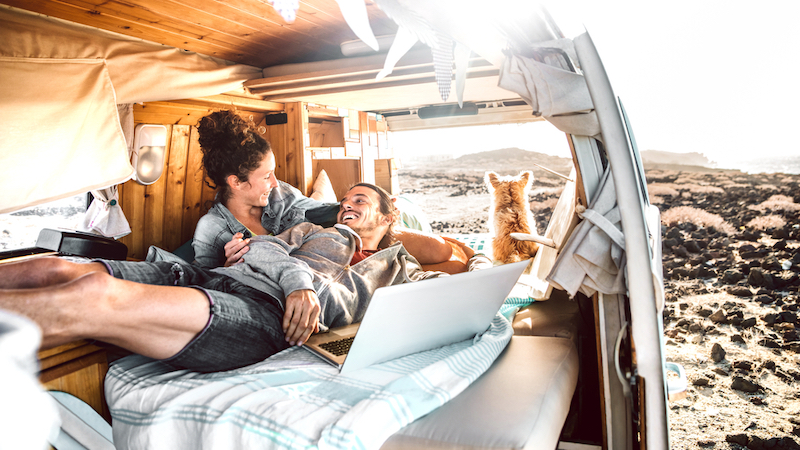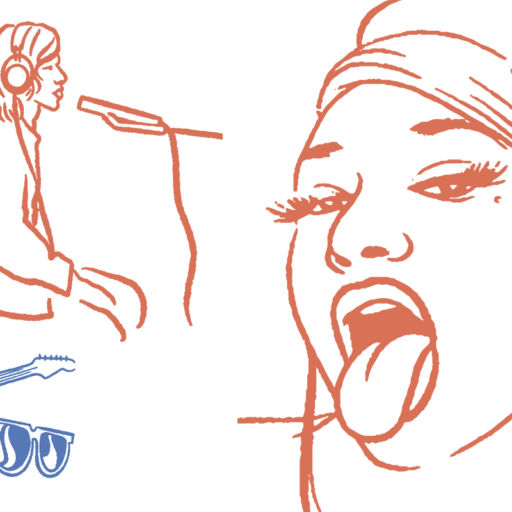I once spent about fifteen months living in a 1997 Dodge conversion van my then-girlfriend and I renovated after college. We yanked out the captain chairs, splurged on a foam mattress topper and shoved in as much underbed storage as we could, setting out from Shreveport, Louisiana with a lot of patterned blankets and no particular destination.
This was back in 2015, when travel influencers and #Vanlife hit a peak in the Insta mainstream. Look up #Vanlife today and you’ll find a glut of think pieces cheering the trend’s demise. A bunch of young, privileged, mostly white millennials, got inspired while scrolling, jumped in vans and then got a healthy dose of reality — that’s the general tone of the idea.
The stats on this supposedly fading trend don’t actually show much fading, though. Van-dwellers in the U.S. nearly doubled since 2020, from 1.9 million at the start of the pandemic to 3.1 million in 2022. For context, that’s more Americans living in their cars than the populations of Wyoming, Vermont, Alaska and North Dakota combined.
The nomads aren’t going anywhere. Here’s a look at the draws and drawbacks, from someone who’s been in the driver’s seat.
REASON #1: MORE MONEY, FEWER PROBLEMS (KIND OF)
Talk to five vanlifers and you’ll hear five reasons for taking up the lifestyle, but it being the cheapest way to travel is often the common denominator. As the average rent-to-income hit 30% for the first time this year, leaving that rent-gouged studio in the city for a (slightly smaller) camper van can seem like a way to bulk up your savings as you hit the road.
When I talked to young couples at RV parks and gas stations around the country, (for a bunch that chooses to live without neighbors, the vanlife community tends to be exceptionally neighborly) I heard the same story again and again. Many chose their vehicles as a kind of short-term austerity measure, a way to get out from under student loans or save up for a house. Gas and food expenses notwithstanding, the savings accrued from even six months of well-planned van-dwelling can make a big difference.
REALITY
The danger of putting all your eggs in one clunky, gas-guzzling basket, though, is that anything can happen on the road. Engines break down, cars get towed, stolen, or crashed into. In fact, three of those four things happened to the van my girlfriend and I shared — luckily, the crash came first, after which no one was interested in stealing it. Then, a few smooth coast to coast runs later, our transmission gave out on the infamous San Francisco hills and we had to roll into a parking space while we called the local repair shops.
And just like that, the good times went up in smoke. Literal, foul-smelling smoke. The cost of rebuilding the transmission would have wiped out all our savings in one fell swoop, so we opted to sell the van for parts, handing the keys to our little rolling home to a complete stranger. It’s one of those stories you don’t often see as you scroll, but it’s all too often how the fun comes to a grinding halt.
REASON #2: THE MOBILE OFFICE
Back in early 2020, remote work was still something someone else did. It was the unicorn of white-collar jobs, rare and coveted. The pandemic changed all that, but studies like this one, from Stanford University, point to the possibility that remote work is here to stay.

For road warriors, this is welcome news. The prospect of working at a tech start-up or a law firm and Zooming in from your Airstream is now a reality for many Americans. Add to that the rise of content creators on sites like OnlyFans, Twitch and Instagram, and the silly-sounding “digital nomad” starts to sound more and more like a proper job title.
REALITY
Working from the road poses a few unique challenges, though, one of them being the eternal wi-fi question. This was one of the most common questions I heard when traveling, often asked with a mixture of skepticism and wonder, the same voice used to ask vegetarians where they get their protein. Vanlifers know the struggle well: hopping around from coffee shop to coffee shop, using your phone as a hotspot for your laptop, dropping an important call at the worst possible time.
It’s a messy patchwork of solutions, but a simpler answer may be on the way with the rollout of Starlink’s mobile wi-fi technology. The satellite company, owned by Elon Musk, has provided subscription-service residential wi-fi to remote parts of the globe since 2019. Starlink recently rolled out a portable, van-mounted option aimed squarely at the digital nomad market, implying that even Musk sees where the current is headed.
REASON #3: EVERYBODY’S DOING IT
Analysts sometimes use a visual aid known as a “diffusion of innovation model” to chart the adoption of a new idea, product or technology within society. These are more commonly called trend curves. For an idea to penetrate the middle of the trend curve, where the mainstream of culture awaits, it must first leap across the so-called “chasm” between the early adopters and the majority.
The chasm is a graveyard, a wasteland. 3D TVs lived and died there, along with Chatroulette, planking, and jello salad. It’s a trash heap of bad ideas that future generations will revisit only to cringe at, or else to recycle what they can. On the other side of it lie all of culture’s unequivocal successes: blue jeans, smartphones, antibiotics.
In recent years, movies like Nomadland have helped to legitimize a van-dwelling lifestyle, while startups like San Francisco’s Cabana are spinning it into a successful business model. If we were to plot out the acceptance of vanlife on a trend curve, we’d probably find it hanging in midair, suspended over the chasm, bolstered by changing economic pressures and buffeted by critics eager to see it fall.
REALITY:
But showering in all-night gyms isn’t for everyone. Moving all your too-big possessions into a storage unit isn’t for everyone. Even those who embrace living in their car do so only for a short time before returning to a more traditional lifestyle.
So blue-jeans-status isn’t really the measure of success here. What made vanlife exciting in the first place was its difference, its countercultural connotation. In that sense, it doesn’t matter how popular or unpopular the practice becomes. There will always be those enthusiasts painstakingly restoring their vintage Westfalias, and there will always be those newcomers in their Starlink-connected Sprinter vans, and their windshields will always look out at the same white lines.




